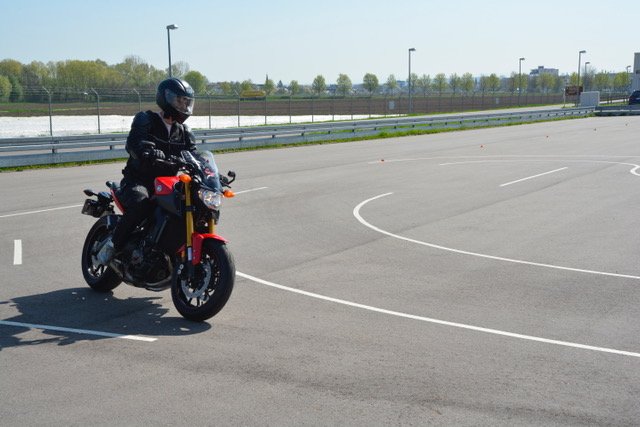
By Greg Jones
USAG Stuttgart Public Affairs Office
As spring weather warms up the roadways, motorcycles are being brought out of storage and back onto the blacktop. While motorcycling can be an incredibly rewarding pastime, it also brings risks and taking steps to manage those risks can help ensure your hobby doesn’t kill you.
Wearing the right gear, keeping riding skills sharp, and inspecting your motorcycle regularly can help reduce those risks.
Motorcycle Personal Protective Equipment includes gear that is meant to protect motorcycle riders and reduce the risk and the severity of injuries in case of an accident. While much of the gear is intended to protect the rider in an accident, some of it is also intended to help prevent the accident in the first place.
Not only is wearing the right PPE good common sense, it also is required by regulation. U.S. Army in Europe Regulation 190-1 is the governing regulation for all U.S. military forces in Europe on matters of vehicle licensing and traffic law. This regulation applies to active duty service members of all four services, Department of Defense civilian employees and family members.
The regulation and an accompanying policy letter require the following PPE:
Head: a helmet properly fastened under the chin. Helmets must meet the standards set by the American National Standards Institute, the Snell Memorial Foundation Standards, the Institut für Zweiradsicherheit e.V. (Institute for Two-Wheel Safety), or the Economic Commission of Europe for bicycle helmets.
Eyes: Eye protection must meet the Vehicle Equipment Safety Commission Regulation standards or the European equivalent. Eye protection must be impact- or shatter-resistant goggles or a full-face shield properly attached to the helmet. A windshield or eyeglasses alone are not proper eye protection.
Hands: full-fingered gloves.
Upper Body: long sleeve, high-visibility, bright fluorescent colored upper body garments (for example, fluorescent yellow, green, red, or orange) for day travel and reflective clothing for night travel. This garment may be a shirt or a jacket, though the Motorcycle Safety Foundation recommends sturdy jackets made of leather or reinforced materials. Operators in military uniform may wear bright fluorescent colored approved motorcycle riding jackets with their uniform. The brightly colored mesh vest commonly used for physical training does not meet this requirement, nor does the physical training, or PT, jacket.
Legs: full-length trousers.
Feet: Over-the-ankle footwear should be made of sturdy leather and have a good oil-resistant sole to reduce slipping hazards. Service boots meet this requirement.
While these policies have been in effect for some time, a renewed emphasis on motorcycle safety has prompted much more stringent enforcement, including a policy of gate security personnel recording infractions and reporting them to the Military Police.
The penalty for failure to wear the proper PPE is the same violation as not wearing a seatbelt in an automobile, and carries a mandatory USAREUR license suspension of seven days. The violator’s license will also be assessed three points.
The standards outlined in AER 190-1 are actually based primarily on a DOD instruction, so they should not be very different than the guidelines in place with the Air Force, Navy and Marine Corps. Also, all of these organizations have based most of their motorcycle safety policies and education on practices and standards set forth by the Motorcycle Safety Foundation.
The PPE listed above protects the rider in two ways. It makes the rider less likely to be in an accident, and it helps reduce the severity of injuries in the case of an accident.
Bright, fluorescent colored clothing makes the rider more visible, and being seen by motorists is the first step to a motorcyclist avoiding a collision. Also, gloves, eye protection, and sturdy boots can protect the rider from the elements, reducing distraction, fatigue and the effects of inclement weather. A more focused rider is a safer rider, according to the MSF.
If an accident does occur, a proper helmet can often mean the difference between walking away and being carried away on a stretcher or worse. The MSF and the USAREUR policy highly encourages sturdy clothing made of leather or reinforced materials, or purpose-made motorcycle clothing. It protects the skin from abrasions and can absorb impact, making broken bones and other internal injuries less likely, or less severe, according to the MSF.
Whether it keeps riders from being in an accident or reduces their injuries, PPE is not only enforceable by military law; it also might just save the rider’s life.
Training is offered through the Installation Management Command Europe Safety Office for motorcyclists of varying skill levels. For military members, a MSF Basic Rider’s Course certification is required.
The following classes are offered to military personnel stationed in Europe:
Basic Rider’s Course: The BRC is an introductory class and is a requirement for obtaining a U.S. forces certificate of license (commonly known as a USAREUR driver’s license) motorcycle endorsement. The course is accepted for up to two years. Riders attending the course must have a stateside license with motorcycle endorsement. In some cases, a motorcycle may be provided. Riders should bring all required PPE with them.
Experienced Rider Course: This course is intended for riders who have at least six months to a year’s riding experience and several thousand miles under their belt. This course will build on the basics in the BRC. Riders are to provide their own motorcycle and of course, all required PPE.
Military Sport Bike Course: Similar to the ERC, this course builds on a basic foundation of skill, but is targeted for sport riders. Riders provide their own motorcycle and all PPE.
The nearest training sites to Stuttgart are Ansbach or Kaiserslautern. Military personnel are encouraged to talk to their supervisors about being allowed administrative time to complete the required course.
Currently, the training is not being offered to civilians, though many local riding clubs and groups conduct their own training efforts.
